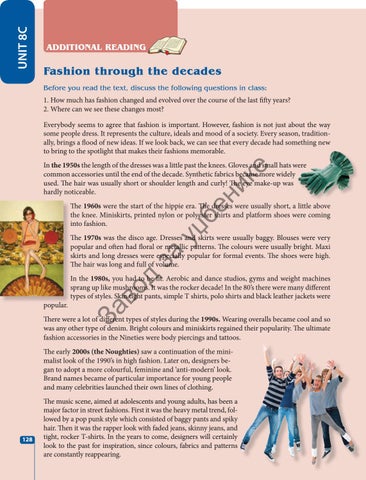UNIT 8C
ADDITIONAL READING
Fashion through the decades Before you read the text, discuss the following questions in class:
1. How much has fashion changed and evolved over the course of the last fifty years? 2. Where can we see these changes most? Everybody seems to agree that fashion is important. However, fashion is not just about the way some people dress. It represents the culture, ideals and mood of a society. Every season, traditionally, brings a flood of new ideas. If we look back, we can see that every decade had something new to bring to the spotlight that makes their fashions memorable.
ни ке
In the 1950s the length of the dresses was a little past the knees. Gloves and small hats were common accessories until the end of the decade. Synthetic fabrics became more widely used. The hair was usually short or shoulder length and curly! The eye make-up was hardly noticeable.
уџ бе
The 1960s were the start of the hippie era. The dresses were usually short, a little above the knee. Miniskirts, printed nylon or polyester shirts and platform shoes were coming into fashion.
за
The 1970s was the disco age. Dresses and skirts were usually baggy. Blouses were very popular and often had floral or metallic patterns. The colours were usually bright. Maxi skirts and long dresses were especially popular for formal events. The shoes were high. The hair was long and full of volume.
За
popular.
во
д
In the 1980s, you had to be fit. Aerobic and dance studios, gyms and weight machines sprang up like mushrooms. It was the rocker decade! In the 80’s there were many different types of styles. Skin tight pants, simple T shirts, polo shirts and black leather jackets were
There were a lot of different types of styles during the 1990s. Wearing overalls became cool and so was any other type of denim. Bright colours and miniskirts regained their popularity. The ultimate fashion accessories in the Nineties were body piercings and tattoos. The early 2000s (the Noughties) saw a continuation of the minimalist look of the 1990’s in high fashion. Later on, designers began to adopt a more colourful, feminine and ‘anti-modern’ look. Brand names became of particular importance for young people and many celebrities launched their own lines of clothing.
128
The music scene, aimed at adolescents and young adults, has been a major factor in street fashions. First it was the heavy metal trend, followed by a pop punk style which consisted of baggy pants and spiky hair. Then it was the rapper look with faded jeans, skinny jeans, and tight, rocker T-shirts. In the years to come, designers will certainly look to the past for inspiration, since colours, fabrics and patterns are constantly reappearing.







































